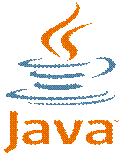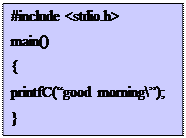
КАТЕГОРИИ:
АстрономияБиологияГеографияДругие языкиДругоеИнформатикаИсторияКультураЛитератураЛогикаМатематикаМедицинаМеханикаОбразованиеОхрана трудаПедагогикаПолитикаПравоПсихологияРиторикаСоциологияСпортСтроительствоТехнологияФизикаФилософияФинансыХимияЧерчениеЭкологияЭкономикаЭлектроника
Programming languages
There are over 200 problem-oriented languages. Most of the languages are oriented toward the particular application areas of business or science (math). The most common of them are COBOL, FORTRAN, PL/I, RPG, BASIC, and PASCAL. It is very difficult to determine what are the most popular of modern programming languages. Some languages are very popular for particular kinds of applications (e.g., COBOL is still strong in the corporate data center, often on large mainframes, FORTRAN in engineering applications, and C in embedded applications), while some languages are regularly used to write many different kinds of applications.

| FORTRANis oriented toward solving problems of a mathematical nature. The name FORTRAN comes from the combination of the words ‘formula translation’. The version of FORTRAN IV has been designed as algebra-based programming language. Any formula or those mathematical relationships that can be expressed algebraically can easily be expressed as a FORTRAN instruction. FORTRAN is the most commonly used language for scientific applications. |
COBOL was the most widely used business-oriented programming language. Its name is an acronym for Common Business-Oriented Language. COBOL was designed to solve problems that are oriented toward data handling and input-output operations. Of course, COBOL can perform arithmetic operations as well, but its greatest flexibility is in data handling. COBOL also was designed as a self-documenting language. Self-documenting languages are those that do not
require a great deal of explanation in order to be understood by someone reading the program instructions. The self-documenting aspect of COBOL is made possible by its sentence-like structure and the very generous maximum symbolic field-name length of 30 characters. With a field-name length of up to 30 characters, the name can clearly identify the field and its purpose.
BASICis the acronym for beginner's all-purpose symbolic instruction code. It was developed in Dartmouth College as an easy-to-learn programming language for students and inexperienced programmers and used as a teaching language. Its key design goal is simplicity. BASIC has become a very popular language in systems where many users share the use of a computer through terminals and it has become a universal language for personal computers. The language BASIC is mathematically oriented, that is, its typical use is to solve problems of a mathematical nature. Because BASIC programs are usually executed from a terminal or microcomputer where input is entered through a keyboard and printed output is relatively slow, problems of a business nature requiring large volumes of input-output data are usually not practical.
PASCALwas invented in 1970 in Switzerland. It was named after the mathematician Blaise Pascal, who invented one of the earliest practical calculators. PASCAL is a mathematically oriented programming language and, as such, is most commonly used in mathematics, engineering, and computer science departments of colleges and universities. This language is somewhat unusual in that it was designed to be a structured language. This means that the program must be written in logical modules which are in turn called by a main controlling module.
| PL/I stands for Programming Language I. It was designed as a general-purpose language incorporating features similar to COBOL for data handling instructions and features similar to FORTRAN for mathematical instructions. PL/I is much more than a combination of the good features of both COBOL and FORTRAN, as it has many capabilities that are unique. Yet, although PL/I is one of the most versatile and the most powerful of the programming languages, it is not the most commonly used. COBOL and FORTRAN have been available for a longer period of time than PL/I, and many more users work with these languages. | 
| |

| C is used to write system software, graphics and commercial programs. C++ is a general-purpose programming language, one of the first Object-Oriented languages. It is regarded as a middle-level language, as it comprises a combination of both high-level and low-level language features. C++ was developed from the С language. It was designed as a systems programming | |
language with features that make it easy to control the computer hardware efficiently. It was used to produce the Microsoft Windows operating system. It is portable, i.e. programs written in C++ can be easily adapted for use on many different types of computer systems.
| Visual Basic is a programming environment, not simply a language. It uses the language BASIC, a simple language developed to make it easy for people to learn how to program. Visual Basic has predefined objects such as dialog boxes, buttons, and text boxes, which can be chosen from a toolbox and dragged across the screen using the mouse and dropped into the required position. BASIC programming code is attached to form | 
|
a complete program. Visual Basic is used to write general purpose applications for the Windows operating system. The language not only allows programmers to create simple graphical user interface (GUI) applications, but can also develop complex applications.
Delphiis similar to Visual Basic. It is also a programming environment for developing programs for the Windows operating system. It has predefined objects that can be chosen from a toolbox. In Delphi, however, the code attached to the objects is written in a form of Pascal. You can think of Delphi as a kind of 'Visual Pascal'. Like Visual Basic, it is often used for general purpose programs.
 Java Steaming Coffee Cup – the Java Technology logo
Java Steaming Coffee Cup – the Java Technology logo
| Javais a programming language developed by Sun Microsystems which is specially designed to run on the web. When you see a web page that uses Java, a small program called 'applet' is executed automatically. Java applets are programs that are embedded in other applications, typically in a Web page displayed in a Web browser. Java applets let you watch animated characters and moving text, play music and interact with information on the screen. Java is an object-oriented language similar to C++ , but it is more dynamic and simplified to eliminate possible programming errors. A Java program is both compiled and interpreted. First the source code (file |
with a Java extension) is compiled and converted into a format called bytecode (file with .class extension), which can then be executed by a Java interpreter. Compiled Java code can run on most computers because there are Java interpreters, known as Java Virtual Machines, for most operating systems, including MacOS, Windows, or UNIX.

| One characteristic of Java is portability, which means that computer programs written in the Java language must run similarly on any supported hardware/operating-system platform. One should be able to write a program once, compile it once, and run it anywhere. End-users commonly use a Java Runtime Environment (JRE) installed on their own machine for standalone Java applications, or in a Web browser for Java applets. |
There are open source tools like applet2app which can be used to convert an applet to a stand-alone Java application. This has the advantage of running a Java applet in offline mode without the need for internet browser software.
Java is multi-threaded. A Java program can have multiple threads (parts), i.e. many different things processing independently and continuously.
People are excited about Java because it lets you create moving images and animated drawings. You can also create graphical objects (e.g. bar charts, graphs, diagrams) and new 'controls' (e.g. buttons, check boxes, pushbuttons with special properties). A web page that uses Java can have inline sounds that play in real-time, music that plays in the background, cartoon style animations, real-time video and interactive games.
One alternative technology is ActiveX, the Microsoft product for including multimedia effects on web pages. Another competitor is Macromedia's Shockwave, a plug-in that lets you animate pictures, add sound and even make interactive pages so that people can play games on websites.
| JavaScriptis a simplified form of the Java language. It is powerful and easy to use. JavaScript was influenced by many languages and was designed to look like Java, but to be easier for non-programmers to work with. Scripts are small programs that can be used to perform simple tasks or tie other programs together. JavaScript is designed for use inside webpages. It can enable a webpage to respond to a mouse click or input on a form. It can also provide a way of moving through webpages and produce simple animation. |  Duke, Java's mascot.
Duke, Java's mascot.
|
1. Decide if the statements are true or false and correct the false ones.
|  This C program tells the computer to print the greeting 'good morning'
This C program tells the computer to print the greeting 'good morning'
|
- Java is not compatible with most computing platforms.
- The Java language is single-threaded, one part executing at a time.
- You can think of Java as a kind of 'Visual Pascal'.
- Java doesn't let you watch animated characters on your webpages.
- VB is considered difficult to learn and use, because of its graphical development features.
- ActiveX and Shockwave are not real competitors for Java.
2. Complete the table:
| Language | Type of language | Characteristics | Use |
| BASIC | |||
| COBOL | |||
| FORTRAN | |||
| PASCAL | |||
| C++ | |||
| PL/I | |||
| HTML | |||
| Java | |||
| JavaScript | |||
| Visual Basic | |||
| Delphi |
3. Answer these questions about special features of the languages:
- Which language uses a system of tags?
- Which languages are designed to be used inside webpages?
· Which language was used to write the Windows operating system?
· What computer language is called a portable one?
· What is HTML used for?
· Which languages can only be used in the Windows operating system?
· Which language cannot be used for writing programs?
Дата добавления: 2014-11-13; просмотров: 743; Мы поможем в написании вашей работы!; Нарушение авторских прав |